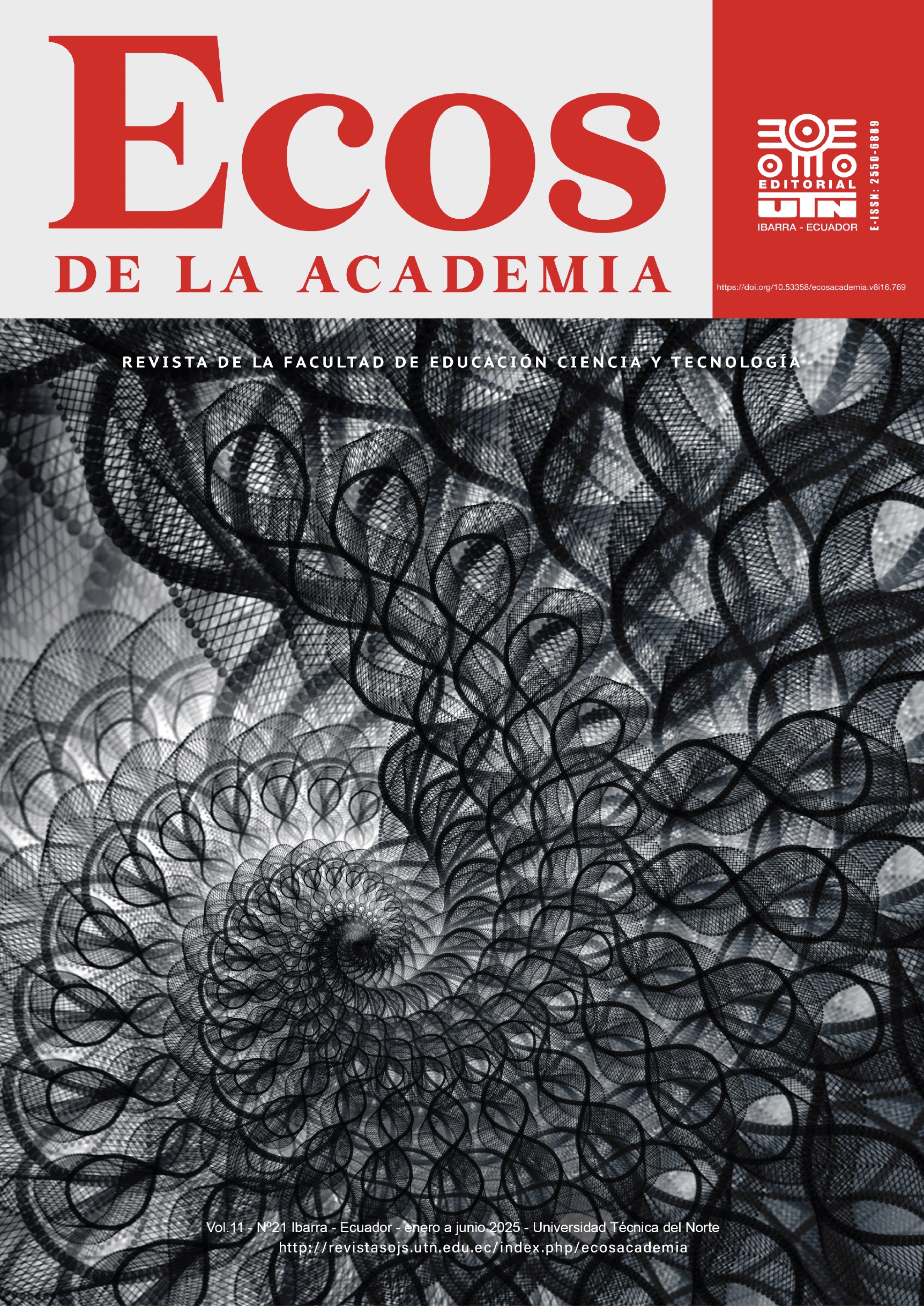Comparison of Anthropometric Indices in Relation to Physical Activity Levels Among University Students
Main Article Content
Abstract
Anthropometric indices are essential for determining risks associated with malnutrition, whether due to weight deficit or excess, and promote well-being strategies depending on physical activity. This study analyzed the relationship between anthropometric indices: body mass index (BMI), waist-to-hip ratio (WHR), and waist-to-height ratio (WHtR) and the level of physical activity in 646 students from the Technical University of Ambato, using the International Physical Activity Questionnaire (IPAQ). The results showed that BMI was the most affected by physical activity, presenting a significant correlation with moderate physical activity (P<0.05), indicating normal values in participants. Light physical activity was positively associated with BMI and WHtR (P < 0.05), indicating that students with low physical activity had higher values in these anthropometric indices. Vigorous activity was associated with WHR (P < 0.05) but did not show a clear effect on BMI and WHtR. In conclusion, anthropometric indices are sensitive to physical activity and vary depending on the intensity and type of exercise. Promoting adequate physical activity is essential to improving body composition and nutritional status.
Downloads
Article Details

This work is licensed under a Creative Commons Attribution-NonCommercial-ShareAlike 4.0 International License.
The authors transfer the publication rights to the journal in all its formats and digital media.
Regarding Copyright CC BY-NC-SA 4.0, this journal is under a license of https://creativecommons.org/licenses/by-nc-sa/4.0/.
You are free to:
Share: copy and redistribute the material in any medium or format
Adapt: remix, transform, and build upon the material
The licensor cannot revoke these freedoms as long as you follow the license terms.
Under the following terms:
1. Attribution: You must give appropriate credit, provide a link to the license, and indicate if changes were made. You may do so in any reasonable manner, but not in any way that suggests the licensor endorses you or your use.
2.Non-Commercial:You may not use the material for commercial purposes.
3. ShareAlike: If you remix, transform, or build upon the material, you must distribute your contributions under the same license as the original.
4.No additional restrictions: You may not apply legal terms or technological measures that legally restrict others from doing anything the license permits.
Notices:
You do not have to comply with the license for elements of the material in the public domain or when your use is permitted by an applicable exception or limitation.
No warranties are given. The license may not grant you all the permissions necessary for your intended use. For example, other rights such as publicity, privacy, or moral rights may limit how you use the material.
LEGAL CODE CC BY-NC-SA 4.0
References
Amparo, L., Martha V., Luz, F., Delia, S., Ramona, M., Eredida, C., Evelia, C., & Karla, H. (2024). Nivel de actividad física en estudiantes universitarios: Nivel de actividad física en estudiantes universitarios. Revista de Desarrollo del Sur de Florida, 3(2), 2257-2263. https://doi.org/10.46932/sfjdv3n2-052 DOI: https://doi.org/10.46932/sfjdv3n2-052
Arrieta, F., Pedro, J., Iglesias, P., Obaya, J. C., Montanez, L., Maldonado, G. F., Becerra, A., Navarro, J., Perez, J., Petrecca, R., Pardo, J. L., Ribalta, J., Sánchez, V., Duran, S., Tébar, F. J., & Aguilar, M. (2021). Diabetes mellitus y riesgo cardiovascular: actualización de las recomendaciones del Grupo de Trabajo de Diabetes y Enfermedad Cardiovascular de la Sociedad Española de Diabetes (SED, 2021). Clínica E Investigación En Arteriosclerosis, 34(1), 36-55. https://doi.org/10.1016/j.arteri.2021.05.002 DOI: https://doi.org/10.1016/j.arteri.2021.05.002
Barrera, R. (2017). Cuestionario.Internacional de actividad física (IPAQ).Revista Enfermería del Trabajo, 7(2), 49-54. https://dialnet.unirioja.es/descarga/articulo/5920688.pdf
Cando, F., Martínez, D., & Pozo, M. (2018). Antropometría: Informes técnicos del Instituto Nacional de Estadística y Censos. https://www.ecuadorencifras.gob.ec/documentos/web-inec/Bibliotecas/Libros/Reportes/Reportes_ENSANUT_Vol3_Antropometria.pdf
Corcoran, K., Denton, D., & Hoffman, J. (2020). Psychological aspects of chronic disease: Chronic kidney disease, chronic pain, and obesity (2nd ed.). StatPearls Publishing. https://www.ncbi.nlm.nih.gov/books/NBK581972/pdf/Bookshelf_NBK581972.pdf
Corvos, C., Corvos, A., & Salazar, A. (2020). Índices antropométricos y salud en estudiantes de ingeniería de la Universidad de Carabobo. Revista de Nutrición , 37(2), 123-130. https://revista.nutricion.org/PDF/caraboboCorvos.pdf
De La Torre, M., Hernández, A., & Ahumada, M. (2022). Relojes circadianos y ayuno prolongado: potencial terapéutico en el tratamiento de las enfermedades metabólicas. Medicina Interna de México, 38(3). https:// www.medigraphic.com/cgi-bin/new/resumen.cgi?IDARTICULO=105784
Fundación Mexicana para la Salud (2017). Riesgo cardiovascular en diabetes mellitus tipo 2. https://fmdiabetes.org/riesgo-cardiovascular-diabetes-mellitus-tipo-2/
García, R., Pérez, M., & Sánchez, J. (2022). Sedentary Behavior and Mental Health Among University Students: A Cross-Sectional Study. Psicología y Salud, 21(1), 27-34. https://www.scielo.org/article/psicosocial/v21n1/12/
Gómez, R., Cossio, M., & Andruske, C., (2020). Composición corporal en estudiantes universitarios: Factores asociados y efectos en la salud. Revista Chilena de Nutrición. https ://doi.org//10.406/S-751
Kaufer, M., & Toussaint, G. (s. f.). Indicadores antropométricos para evaluar sobrepeso y obesidad en pediatría. https://www.scielo.org.mx/scielo.php?script=sci_arttext&pid=S1665-11462008000600009
Lozano, J., García, P.,& Ruiz, P. (2022). Índices antropométricos y su relación con el riesgo cardiometabólico en estudiantes universitarios. Medicina Universitaria, 24 . https ://doi.org/10/j.m.2022.04
Mendoza, M., Muñoz, A., & López, J. (2021). Nutrición y enfermedades metabólicas. Revista Científica de Saberes y Transdisciplinariedad, 2(4).https://sicru.org.bo/index.php/cognis/article/view/11
Mora, E., & Araujo, M. (2022). Relación entre la antropometría y las capacidades físicas de potencia, velocidad y agilidad en futbolistas. Redalyc, XII(2), 1-15. https://doi.org/https://doi.org/10.29035/rcaf.23.2.3 DOI: https://doi.org/10.29035/rcaf.23.2.3
Organización Mundial de la Salud. (2020). Actividad física. https://www.who.int/es/news-room/fact-sheets/detail/physical-activity
Organización Mundial de la Salud. (2023). Obesidad y sobrepeso. https://www.who.int/es/news-room/fact-sheets/detail/obesity-and-overweight
Organización Mundial de la Salud. (2024). Actividad física. Recuperado de https://www.who.int/es/news-room/fact-sheets/detail/physical-activity
Protocolo ISAK. (2023). Protocolo ISAK: Evaluación antropométrica. Scribd. https://es.scribd.com/document/647685489/Protocolo-ISAK-Evaluacion-Antropometrica
Quinde, Z., Heredia, A., y Correa, B., (2024). Niveles de actividad física en estudiantes universitarios: análisis en función del género. Portal De La Ciencia , 5(2), 181–191. https://doi.org/10.51247/pdlc.v5i2.433 DOI: https://doi.org/10.51247/pdlc.v5i2.433
Roque, E., Saldaña C., Alburqueque, J., Roque, E., Saldaña, C., & Alburqueque J. (2020). Índice cintura-talla: un marcador de obesidad visceral relacionado a cistitis no complicada. Revista de la Facultad de Medicina Humana, 20(1), 27-31. https://doi.org/10.25176/rfmh.v20i1.2545 DOI: https://doi.org/10.25176/RFMH.v20i1.2545
Salamanca, G., Castro, L., González, A., Vásquez G., & Ríos, G., (2022). Actividad física y percepción de salud en adultos jóvenes universitarios. Hacia la Promoción de la Salud, 27.https://doi.org/10/a.2022.27.1





